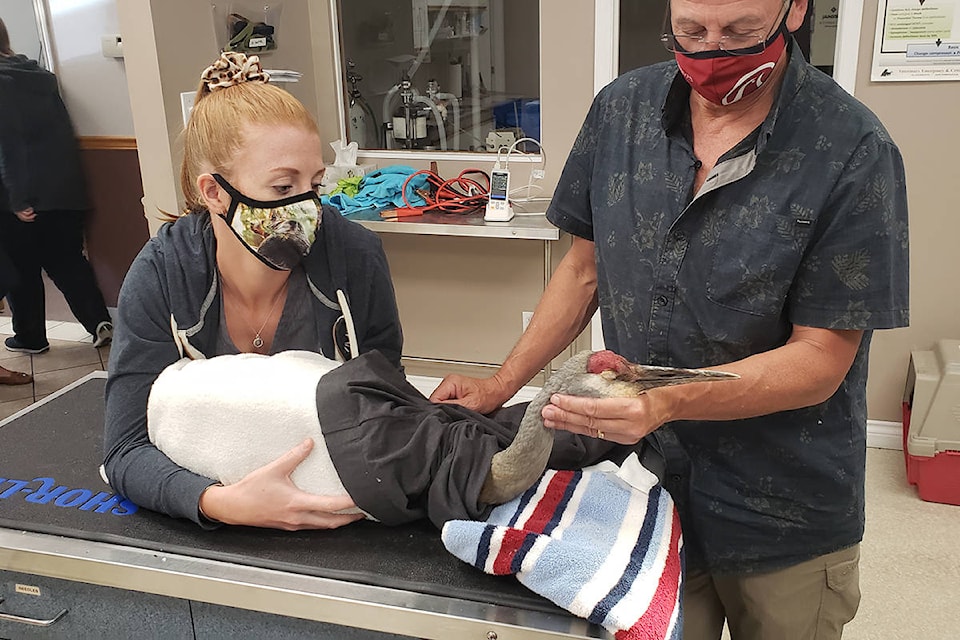A sandhill crane that had been nursed back to health after suffering a broken leg was released back to the wild in Pitt Meadows on Saturday.
The bird, which has been named ‘Fraser,’ by its rescuers had been struck by an errant golf ball this summer, and was captured to give it a fighting chance at survival.
Its mate had also been hit, but was not as lucky.
Wildlife biologist Myles Lamont said a passionate team of veterinarians have spent the last several months donating their time, materials, and expertise to care for Fraser.
Dr. Adrian Walton from Dewdney Animal performed the original surgery after capture, Dr. Ken Macquisten aided in post operative care and subsequent treatment, and Elizabeth Melnick from Elizabeth’s Wildlife Center, has helped with rehab of these golf ball injured birds for the last several years.
“They have likely invested several thousands of dollars worth of surgery time and medical support with zero compensation, so they deserve to have some recognition for their community support,” said Lamont.
READ MORE: Climate change threatens extinction for most birds, especially in Canada: report
Fraser will be fitted with a GPS transmitter so his movements and recovery can be tracked.
Lamont, who provided the majority of the funding for the transmitter, said it will help contribute to our limited understanding of this unique sub-population of sandhill cranes.
“With less than approximately 12 breeding pairs left of the South Coastal sandhill cranes in the Fraser Valley, this population is facing severe threats from urban expansion, loss of wetland habitats to agricultural development, and increased threat of golf courses as they continue to be forced onto these sub-optimal habitat types and subject to injury,” Lamont said.
The crane was let loose in the Pitt Polder Ecological Reserve, one of the last viable habitats for the birds.
Lamont said it was in Fraser’s best interest to be released now.
“I’m hoping he’s got a couple weeks here of some fairly mild weather, so he can acclimatize and join a bit of a small flock that usually hangs out in the Pitt [Polder] this time of year.”
Of note, is the cultural significance of the species to local First Nations people.
“It’s the only First Nations culture that I know of that has such a close tie to cranes,” Lamont said.
“According to Katzie oral history, the sandhill crane was one of the most important animals in their culture and was highly revered, with their name for the crane being “haha´w ” which means “superior in everything.
“In March, thousands of sandhill cranes would stop over in their traditional territories along the Pitt River and stage prior to moving north, and they termed March the “month of the crane” or ” li-´mƏs ” in their traditional language.”
He estimated there are between 30 to 35 birds in the lower mainland, and would like their status changed from ‘Non-threatened,’ to ‘Threatened.’
“It is terribly low, and unfortunately has not received any concern or attention from either provincial or federal governments in the last decade,” Lamont said.
“I’m trying to lobby them to re-look at this species because 30 birds is not very many and their recruitment is terribly abysmal.”
He pointed out less than 3 per cent of the birds that hatch actually make it to adulthood.
“It is not high enough to maintain the population, and we’ve lost ten birds in the last five years to golf ball strikes. The whole thing is a recipe for disaster because it can take five years for them to reach maturity,” he said.
“So the population will not be able to sustain itself with those kind of fatalities continuing.”
ronan.p.odoherty@blackpress.ca
Like us on Facebook and follow us on Twitter
